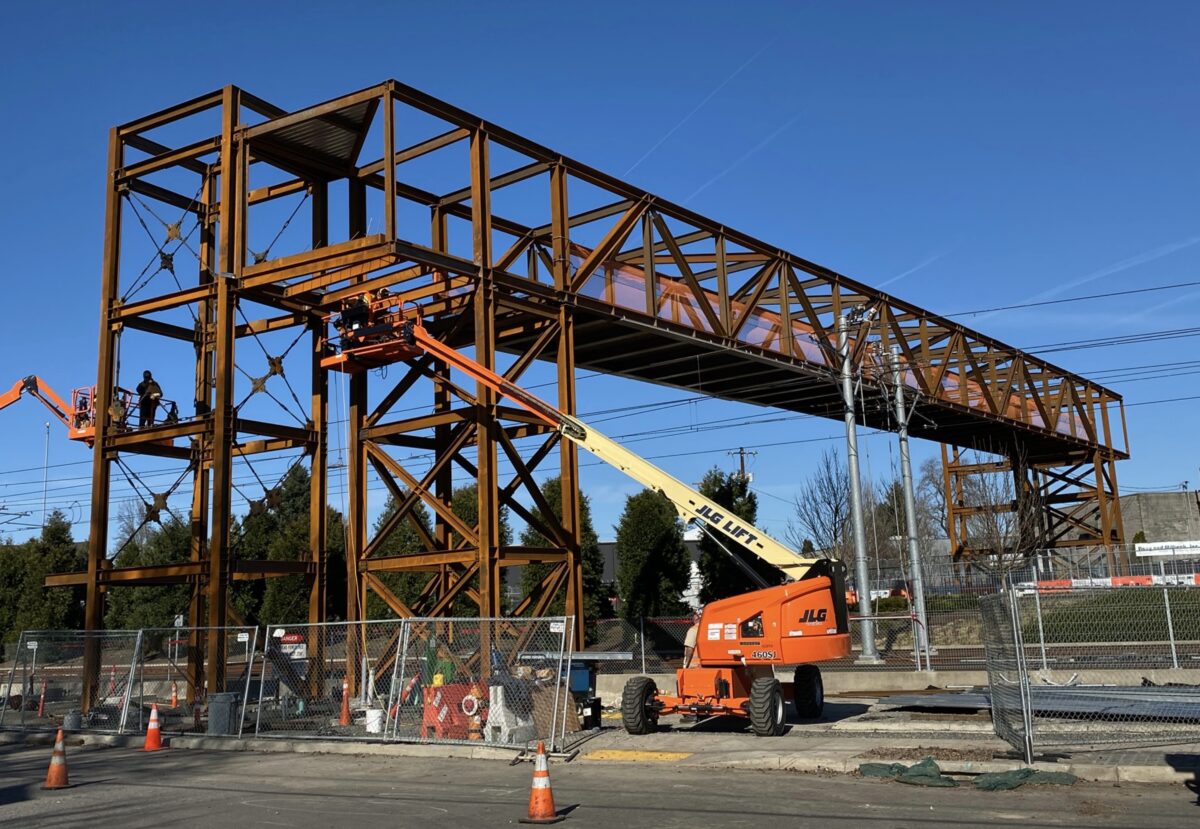
(Photos © J. Maus/BikePortland)
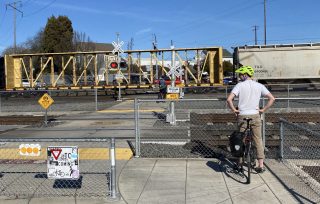
On my way to check out the new Gideon Overpass yesterday I passed an all too familiar sight: a freight train blocking people from crossing the tracks at SE 11th and Clinton. This issue torments many people and is a recurring mobility nightmare for anyone trying to get between the Brooklyn and Hosford-Abernethy neighborhoods. It’s so bad someone made one of those singularly-focused websites about it with the address of IsATrainBlocking11th.com.
Soon the wait will be over.
Construction crews are busy these days erecting a new bridge that will give people an option for getting around trains that doesn’t involve lifting bikes over stalled or slow-moving train cars (yes people do that). The new Gideon Overpass already stands tall above the tracks about 300 feet southeast of the Clinton St/SE 12th Ave MAX station.
(Photos © J. Maus/BikePortland)
Advertisement
With intense opposition from nearby business owners behind them, TriMet is on track to complete construction of the $15 million bridge by this fall. For bicycle riders, it will have a roll-on elevator just like the nearby Rhine-Lafayette Overpass. When the elevator is broken, a wheel gutter will help roll bikes up and down the stairway.
One business owner can’t wait for it to be done. Jarret Walker of Jarrett Walker + Associates calls the bridge a “game-changer for the area.” “My office is on the north side and I must plan my life as though 11th-12th is permanently blocked by freight trains,” he shared on Twitter this morning. “There are things on the other side I’d love to go to, but the risk of being stranded there is too great. Go TriMet and PBOT!”
— Jonathan Maus: (503) 706-8804, @jonathan_maus on Twitter and jonathan@bikeportland.org
— Get our headlines delivered to your inbox.
— Support this independent community media outlet with a one-time contribution or monthly subscription.



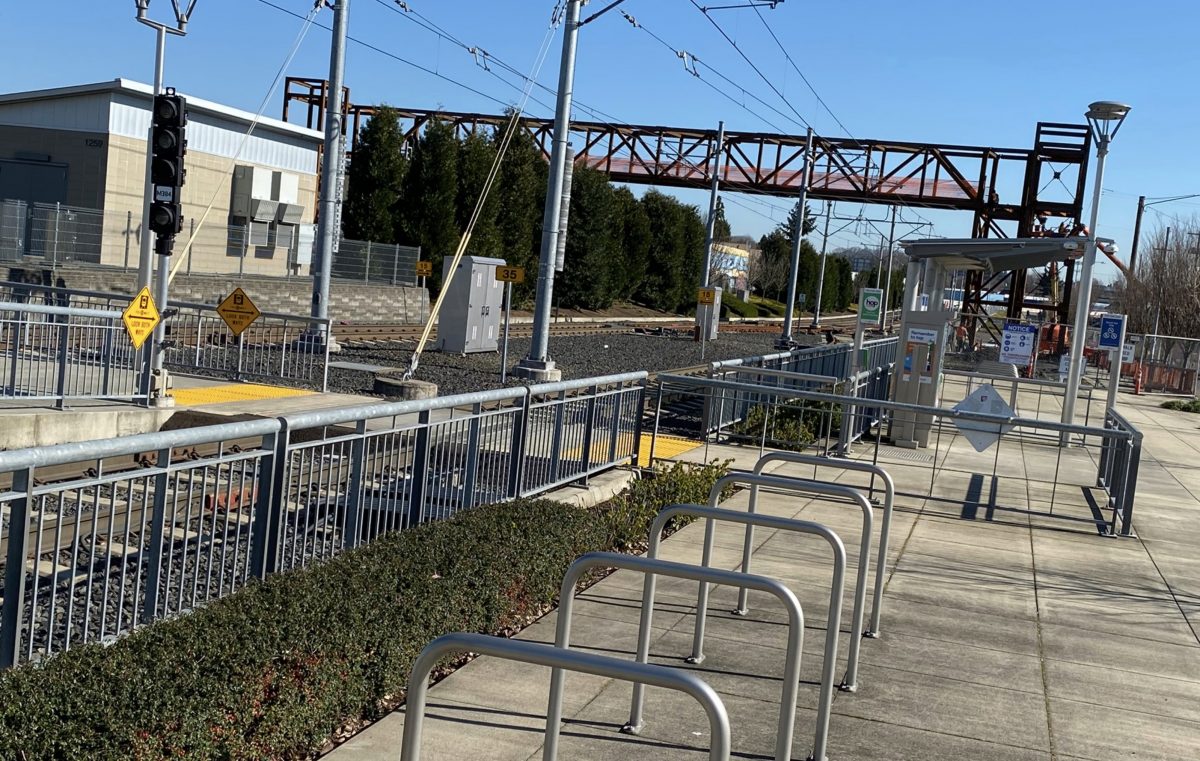
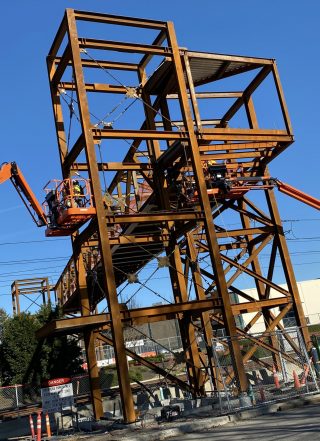
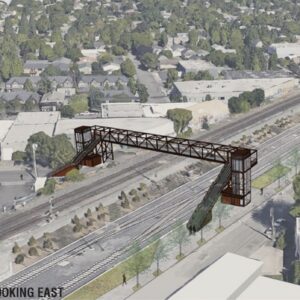
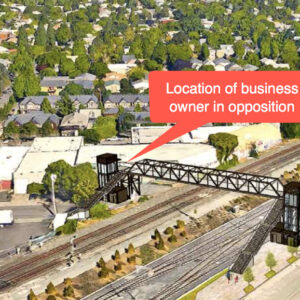

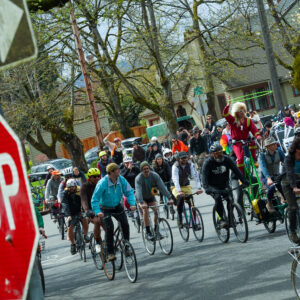
Thanks for reading.
BikePortland has served this community with independent community journalism since 2005. We rely on subscriptions from readers like you to survive. Your financial support is vital in keeping this valuable resource alive and well.
Please subscribe today to strengthen and expand our work.
Wonder if they will also replicate the horrible wheel-gutter design from Lafayette/Rhine overpass steps. The placement of the handrail on the stairwells render the wheel-gutters all but useless (or you could say that the placement of the wheel-gutters render them all but useless).
I hope Tri-Met can apply some of the lessons-learned in the design of this new one.
At a neighborhood association meeting with planners a couple of years back, one of the planners arrived by bike, and I suggested she go actually use the wheel gutters at Lafayette before finalizing the design. She did, understood the problem, and claim that the new design will suck less.
We’ll see.
I can say with some level of confidence that they won’t suck more.
Does anyone know what happened with the Camera Rental Place that opposed this. Are they still there and dealing with it, or did they move?
The 11th/12th/Clinton mess is part of my commute, so I’m really excited to see this being built.
That said, I can’t help but wonder…. how is the freight train enough of an issue to necessitate spending $15M getting peds/cyclists over the tracks, but is also enough of a non-issue to route the Division Transit Project across the tracks at grade (at SE 8th I think)?
I’ve asked this question probably a dozen times. The answer is simple: “the switch”, by which they mean the expensive switching equipment that TriMet is buying for Union Pacific that will resolve some of the cases where the train is parked not moving on the tracks. Of course, if you’ve been stuck there, you know that this accounts for a minority of blockages.
I think the answer is 5% the switch, 95% a river in Egypt.
Yeah, I’ve heard some mention of “the switch” – definitely agree that if it can’t somehow greatly reduce the duration of the “normal” obstructions, then it’s inadequate. Trains are long! I think the real fix for DTP wouldn’t be trivial (interesting idea for 7th), and TriMet has buried their head in the sand here rather than acknowledge that.
I mean, the cognitive dissonance in their own plans: train obstructions will soon be short enough for the DTP to cross the tracks without making everyone late to work… yet still long enough that folks will walk blocks out of their way to use an overcrossing?
I get it – separate projects, FTA funding for overcrossing, etc etc. – but still… the whole thing just doesn’t add up.
A bridge that tall, that can support a bus, with ramps that a bus can use to get up onto it, is a whole different ballgame and a bigger horizontal footprint that would probably wreck both neighborhoods.
Speaking about 11th/12th, you’d put the bridge launching from 7th on the north of the tracks to 8th on the south. 7th is almost high enough that the bridge would probably only need to climb 5 ft, and there is a vacant lot and a bus-only street on the south to work with.
It’s totally doable with no demolition and little impact on existing tenants.
Bus should take the elevator, for same reasons they did not put in ramps for cyclists.
Will Trimet be erecting any signage alerting bikes, peds, & MAX riders to the location of the new bridge? Or is it just really obvious already and in plain sight from the train crossing?
It’s not even done being built and is already unmissable from the intersection. I think people will figure it out very quickly.
When traveling eastbound (on SW side of the tracks when you are stopped by a train) you can see the elevator overpass from 11th/12th.
However, when traveling westbound on Clinton you will have to know to look up ahead and see if you see a train on the tracks and then make a left turn on 14th and ride about 1 1/2 blocks to the elevator/stair. They will probably put up a sign on Clinton.
May be worth noting that the original South/North Light rail proposal that was voted down by a slim margin in ’98 had an underpasses at SE 11th/12th and an overpass at N. Interstate just west of the RQTC. Without the bond money it was done in pieces and at lower cost and has yet to get to Vancouver!
A tunnel would seem infinitely better, much less elevation change, but I have learned that folks don’t like tunnels because of the unsavory folk who might ruin the experience. For the (how many?) millions a tunnel would save we could surely have bought some bright lights, colors, cameras, etc. to improve the chances it would be pleasant.
They should have built the entire MAX system underground in a tunnel, ala San Fran’s BART system!
Then there would be no interruptions of service, no blocking roadways with trains etc, and operational running costs would have been lower, as trains could have been twice the length (downtown block length prohibits longer trains.) An underground light rail would have also eliminated fare evasions, as it would have been a closed, not open, system.
But it would have also been expensive, so I get it.
It’s helpful, I think, to understand that Portland’s growth until 1990 or so was always slow and anemic. Like most US cities, it only grew in population by annexing territory, and even then it sometimes shrank. When it built the Blue line in the 1980s, the city barely had more than 350,000 people – it was on the small side for having any mass-transit system. It’s post-1990 growth has been exceptional, but its sudden increase in urban density is even more phenomenal, given that it effectively stopped annexation in 1991. What you are seeing now is “growing pains” from adding 300,000 new residents in an area that was never really prepared to have them – crowding, congestion, mode conflicts, rapid increases in the cost of living – things the Bay experienced decades ago and Eastern industrial cities over a century ago. And yeah, logically either the railroads need to be elevated or mass transit needs to go underground (or both), but that costs lots of money, as it did way back when for the other cities too.
It’s an appealing idea to put the entire MAX system underground, but it also runs into the problem of high US subway construction costs. The cheapest recent US subway, the one in Seattle, cost $600 million per mile. Even if costs could be cut to match the expense of subways in Paris—surprise! Much cheaper than US costs—subway construction outside of downtown would be prohibitive.
That said, the downtown subway that TriMet is considering would be a great idea.
FYI ALon Levy has written extensively on this issue. For example, see https://pedestrianobservations.com/2019/03/03/why-american-costs-are-so-high-work-in-progress/
The MAX isn’t the problem, and the earlier MAX plan would not have fixed hey problem.
An underpass tunnel would have been infinitely better. I met planners and engineers onsite together with other pedestrian and bicycle advocates to specifically ask for this during the design stage of the Clinton LRT station project.
I bike through this intersection routinely. I use the underpass along Powell Blvd. from 18th to Gideon/13th Pl. whenever I have to be somewhere by a certain time and don’t have to time to wait for a potential freight train, about 2 – 4 times a week. It is lined with 2 – 6 occupied campsites that almost always leave a narrow passage for bicyclists and pedestrians to get through. I have never had a negative interaction there with campers. I began avoiding it at night when it became a camping location.
Trimet not only does not take steps to keep this transportation corridor free and open, they have actively abandoned all maintenance of the expensive landscaping that was installed as part of this project. They failed to water or weed and now it is nothing but huge weeds and trash. There is even a growing little grass lawn island in the middle of the MUP on the east side before you enter the tunnel from dirt and seeds that have apparently blown there and continue to build.
When an engineer excitedly told me in June of 2018 about the recent decision to build this Clinton elevator overpass and I mentioned that I use the Powell underpass, her response was “Ewwwwe – yuck.” This is why we can’t have nice things.
Read up on urban tunnels and how they quickly become living spaces for the unhoused. In SLO, they actually have a group of people who shepherd cyclists and peds through the campus tunnel which has become the home of very unsightly denizens.
Like I said above, it is hard to fathom that in the richest country in the world we couldn’t come up with a friendly, happy, safe, welcoming tunnel design in situations like this. Especially if we have $15M to blow on this.
I agree. Like I said, tunnels become homeless camps, because they are shelters. So, you need to figure out a way to go under a road, that is not an attractive place to ‘camp’. Interesting design challenge. Maybe hard-wired for constant, loud classical music? Only half-kidding.
“So, you need to figure out a way to go under a road, that is not an attractive place to ‘camp’. Interesting design challenge…”
Hardly difficult. Especially when money is (well, was) on the table. Put a franchise down there; sell waffles; install bright lights; there have to be a hundred ideas for how to solve this.
Anyone who can find a formula that works at making money while deterring bad behavior will have numerous franchise opportunities up and down the west coast, and will likely get rich. There’s no shortage of places to test the concept.
The problem isn’t, in my view, any lack of opportunity to succeed here; the problem is that the bureaucracies and committees who get to decide these things lack imagination, creativity, can’t think outside the proverbial box.
Or, maybe, not enough people want to hang out under an underpass eating waffles to support a viable business. I don’t think we’ve seen many workable models for how to do this because there’s not a lot of good solutions…
Short of, that is, building a more comprehensive healthcare system, including robust treatment for mental illness and drug addiction (and a plan for managing those who don’t want treatment), along with an ample supply of housing accessible to low-income folks, services to support (or prevent) kids running away from abusive households, and probably a bunch of other things I didn’t mention.
Alright, skip the waffles. A needle exchange with hot coffee instead, staffed by Multnomah Co. Health dept. There are endless possibilities here. Your insistence that because we haven’t heard of a simple fix it must not be possible is not inspiring, doesn’t lead to innovation, solutions.
I do not believe there is some simple fix that everyone has somehow overlooked, but if there is, I will embrace it. Please don’t let my skepticism slow you down. I love being proven wrong.
On further reflection, there may in fact be easy solutions. Boulders, for example, seem to be effective in deterring campers.
So maybe I was overly hasty in poo-pooing your “simple solutions”. Fill the underpass with boulders. And be prepared for the backlash from folks who oppose “solutions” to camping.
The solution to homelessness is actually ridiculously simple. No one has the gumption to enact it. See, they aren’t homeless… if you give them a home. It’s really that simple.
Also, homelessness is an inevitable outcome of capitalism.
https://getpocket.com/explore/item/it-s-a-miracle-helsinki-s-radical-solution-to-homelessness
Homelessness is not at all an inevitable outcome of capitalism. There is nothing preventing a capitalist society from providing housing for the poor (for example).
Capitalism is all about the individual and pulling oneself up by their bootstraps. Being homeless is a state bereft of the capital to pay for a home; be it by rent or by mortgage. To solve homelessness, homes would be freely given. Free property is an acronym to capitalism.
* An affront to capitalism.
>>> Capitalism is all about the individual and pulling oneself up by their bootstraps. <<<
Not at all; it's a model where people control the capital and own the businesses individually, rather than collectively through state government. This usually means robust property rights, free(ish) markets, and the rule of law. All of which are independent of social welfare. Sweden, for example, is quite capitalist and has a comprehensive safety net.
Solving the homelessness problem by giving away "free property" is unlikely to be effective, even if we could afford to do that.
The moral doctrine of individualism, the notion that individuals need freedom to flourish and an individuals right to live their life as they choose suggest that helping the destitute is a disservice.
Also, Thank you for reinforcing my claim that the simple solution will not be implemented.
>>> helping the destitute is a disservice <<<
This is not a property of capitalism. There are a multitude of counter examples, on the individual, organizational, and government levels.
I think you have a fundamental misunderstanding of what capitalism is. You can read more about it here: https://en.wikipedia.org/wiki/Capitalism
After you bone up, you can have the last word.
You’re no longer debating me, now you are just telling me to shut up – essentially. And you’re calling me uneducated. So, since you’re tact has broken down to personal attacks, I’m finished with this conversation. I think you should take a step back and extricate your emotions from the conversation.
Dozens of cyclists and pedestrians can be waiting for a train to clear, especially at rush hour.
How many of those dozens of people and their wheeled conveyances can fit into one ride in the elevator car?
At the next stop of the Orange Line south of Powell, I timed the Rhine-Lafayette elevator overpass. It takes about 3 min from the time you enter the elevator til the time you exit on the other side of the tracks. If you have just missed the elevator, you are waiting 54 seconds for it to return for the next ride. If you’re standing in line, add that times two (two elevators – one at each end) then multiply again by the number of groups filling the elevator who are ahead of you in line.
Not everyone can shoulder their wheeled conveyance and cargo and climb the steps. Even if you can, this is still a time delay.
If your route is north-south rather than east-west, the Clinton elevator overpass takes you 1/2 mile out of direction. This is especially significant for pedestrians.
An over or underpass MUP was called for at this location.
This elevator bridge is being built with money left over from the Tilikum Bridge. BikeLoud advocates asked for multiple improvements on the Tilikum design that I would have rather seen this money used for.
If you are on a bicycle and faced with more than a 2-3 minute wait for a train here, you can easily hop over to 17th/Powell and get around the stopped train using the existing, (recently upgraded, or I should say grade-leveled) underpass sidewalk on the N side of Powell. This has always been available – not sure why people wait so long on a bike, here.
This is probably too long of a detour for a pedestrian, but for a cyclist, it is very short – a few blocks from 12th Clinton up to 17th Powell. The South side puts you out exactly where the new bridge will drop you.
This. It is an automatic fix if you are going eastbound, and works a bit less well if you are going westbound (which may require one to double back if the train arrives when you are near to 12th).
I see from the master design that they have deliberately built into the plans to eventually have long bicycle ramps leading to the bridge on both sides. Any idea when they’ll get built?
I am confident the answer is a resounding “never”.
There will be no long bike ramps. TriMet claimed that there is insufficient room, even in the large space next to the Clinton Street max stop.
It’s been argued that a better fix would be to put the railroad in a cut through the area https://portlandtransport.com/archives/2007/10/a_hosfordaberna.html
This should have been done when the orange line was built.
The real delay is not the light rail but the heavy rail – Southern Pacific. The light rail is concurrent with the SP lines. So, moving the light rail wouldn’t have a tremendous benefit. In fact, it would just pose a secondary delay elsewhere.